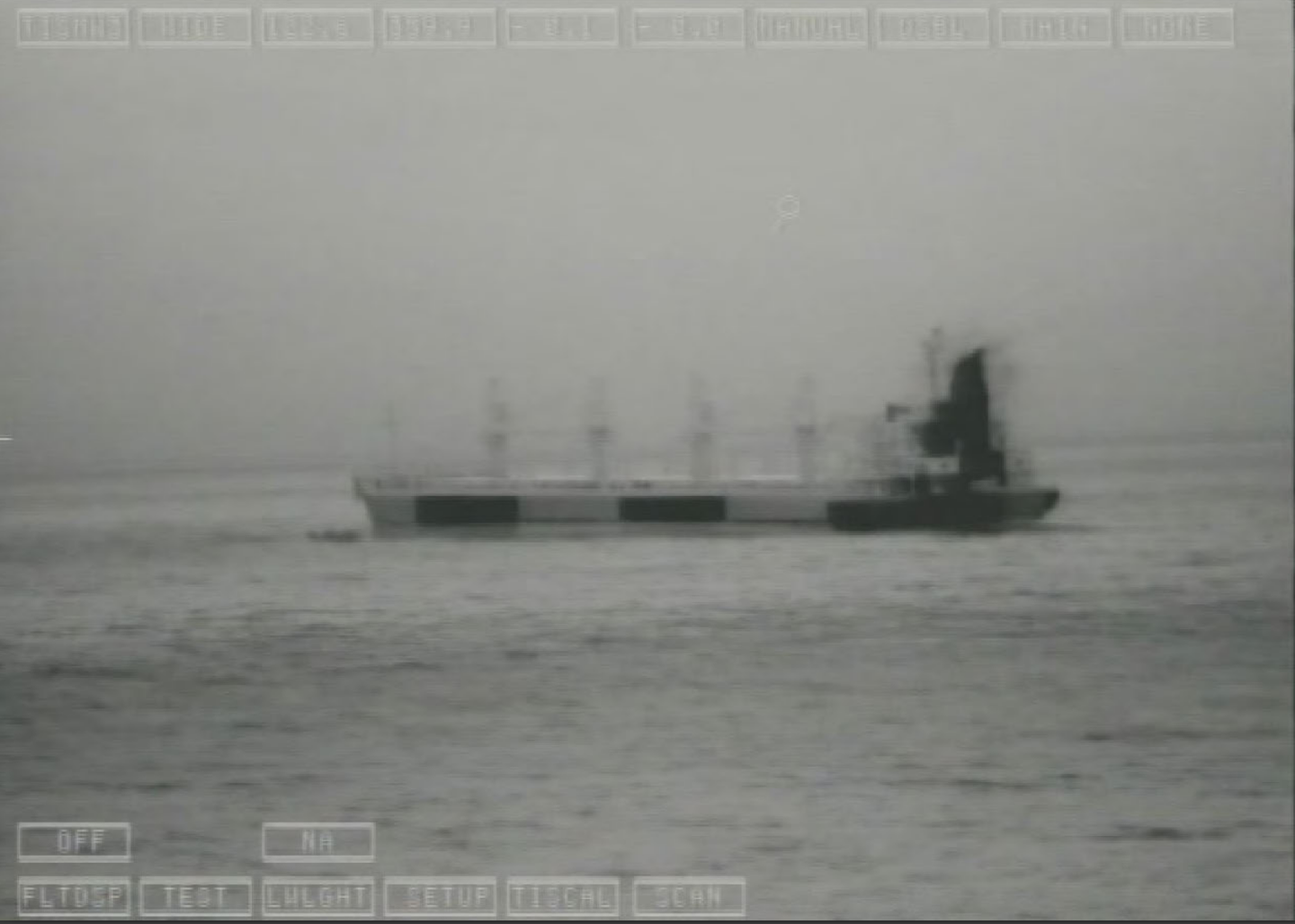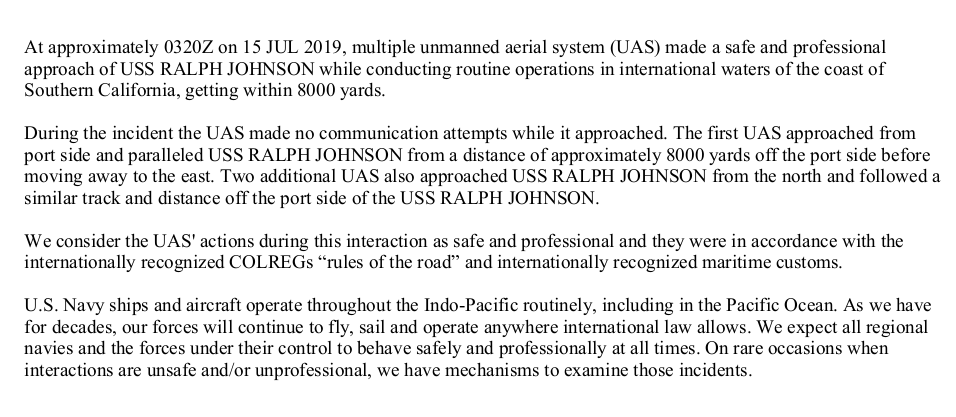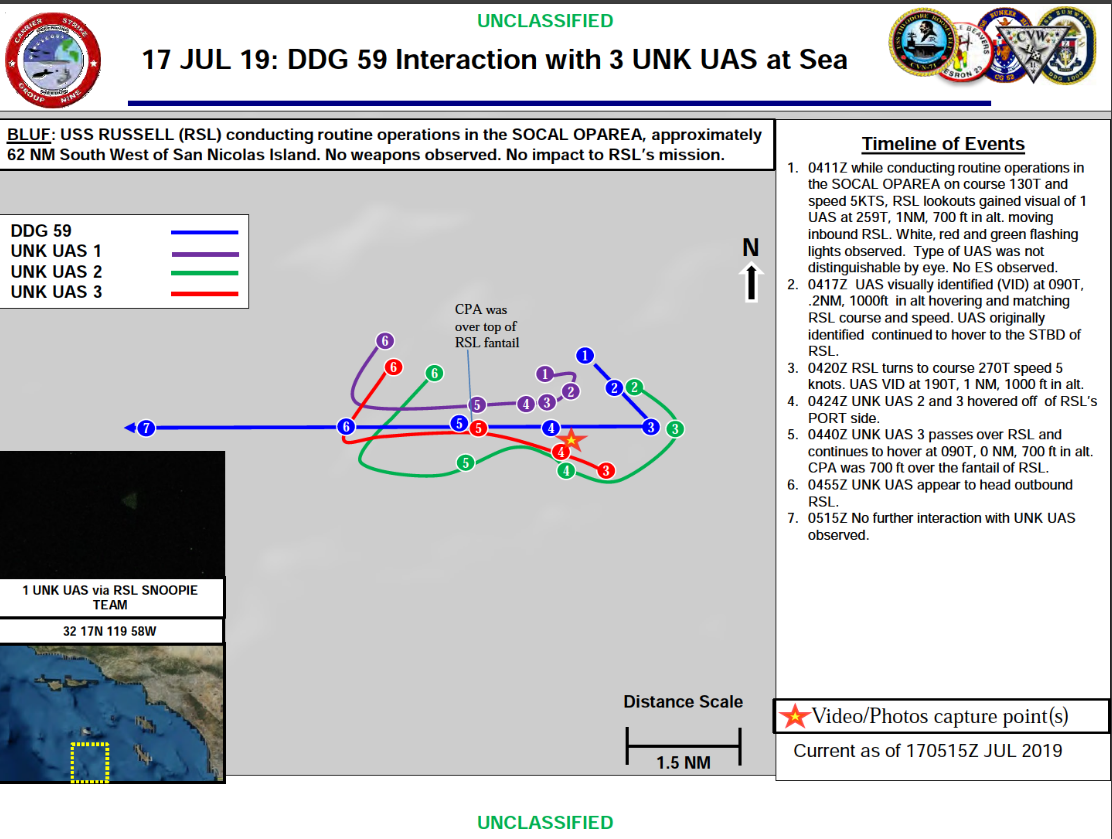14.06.2022

Drone Swarms That Harassed Navy Ships Off California Demystified In New Documents
A major release of documents provides the highest level of detail yet about mysterious drone swarms involving U.S. Navy ships off California.

The War Zone has received a highly significant new set of documents from the U.S. Navy via the Freedom of Information Act about a series of enigmatic drone swarm eventsthat occurred in the waters off Southern California in 2019. These incidents have come to be woven into an ongoing discussion about unidentified aerial phenomena, traditionally known as UFOs. In previous weeks, top defense officials told Congress that the 2019 swarm incidents were caused by drones. These new documents leave little doubt in that regard.
The documents include unprecedentedly detailed briefing materials and photographs from more than a half dozen incidents. Among these new incidents are previously unknown events that occurred in the early months of 2019 and were assessed by the Navy to involve intelligence collection operations. The new photographs also include images of drones apparently operating from an unresponsive civilian ship that was shadowing Navy vessels.
Speculation has swirled around these incidents in the last year, following high-profile leaks of night vision video footage depicting objects with an apparent triangular shape overflying Navy vessels. The unusual appearance of the objects led to widespread speculation that they were otherworldly UFOs, despite evidence that the Navy regarded the objects as conventional drones. The video was recently discussed in a congressional hearing on Unidentified Aerial Phenomena as an example of a solved case. According to Deputy Director of Naval Intelligence Scott Bray, the video was definitively identified as an unmanned aerial system (UAS) following a second swarm event that occurred off the East Coast of the United States this year.
Our previous coverage began with a series of drone incidents that occurred on July 15th, 2019 approximately seventy nautical miles off the east coast of San Clemente Island. A tranche of deck logs from Navy vessels indicated that several ships had encountered drones over an extended period of time.

We previously reported the close presence of several civilian vessels in conjunction with these sightings, notably the Hong Kong-flagged bulk carrier MV Bass Strait. Our initial investigation leveraged automatic identification system (AIS) ship location data in conjunction with deck logs to reconstruct the incidents. The terseness of the deck logs and limitations in AIS data left several unanswered questions, such as the origin of the drones and the specifics of their flight behavior. Many of those questions can now be answered.
Among the new documents released to us is this briefing slide, which depicts the course of the Bass Strait relative to the Arleigh Burke class destroyer USS Paul Hamilton, also abbreviated here as PHM, as it transited to a scheduled port call in Long Beach, California. The briefing slide states that the Navy assessed that the commercial cargo ship was likely conducting surveillance on Navy vessels using drones, or unidentified aerial vehicles (UAV). A timeline of events shows that the surveillance lasted for just under four hours. In that time, multiple UAVs were spotted operating around the destroyer.
An email sent on July 15th matches these details and references a number of images and one video file. These images were captured by the Ship Nautical Or Otherwise Photographic Interpretation and Exploitation team, or "SNOOPIE team." These teams consist of sailors trained to conduct onboard photographic intelligence in order to document unknown contacts and events of interest.

The images from the incident include these photographs of what appears to be the Bass Strait. The Bass Strait's owner and operator, Hong Kong-based Pacific Basin, did not reply to several requests for comment. In several of the pictures, dark spots presumed to be drones can be seen operating around the vessel:



Similar briefings were prepared by other Navy vessels involved in the incidents. The Ticonderoga class cruiser USS Bunker Hill (BKH) noted as many as 11 drones operating nearby. A note on the slide states that the cruiser unsuccessfully attempted to contact the Bass Strait. It also indicates that the UAS incident continued after the Bass Strait departed the area. The exact duration of the incident is less clear, though the timeline indicates drones were spotted over a period of about four and a half hours.
The timeline also indicates that Bunker Hill's AN/SPY-1 radar system held "valid tracks" of the drones, including up to an altitude of 21,000 feet. Although an image of one of the drones is hard to identify in the slide, a caption describes the objects as “Quadcopter style UAS.”

Finally, the USS Ralph Johnson (RJN), another Arleigh Burke class destroyer, also prepared briefing slides about the incident. They described intermittent radar tracks of the objects. A legend on the slide shows at least four UAS tracks, and the timeline mentions that lights from as many as 10 additional drones were visually spotted.
Notably, Ralph Johnson assessed the UAS as operating in a “safe and professional approach” that was "in accordance with the internationally recognized COLREGs 'rules of the road' and internationally recognized maritime customs" in a draft public affairs statement. It is unclear if this assessment was shared by the other vessels.

An email dated July 14, 2019, sent while the incident was in progress, stated that there was a pause between periods of UAS activity. The email further states that no counter unmanned aerial system (CUAS) measures were deployed during the first phase and that the USS Ralph Johnson was not at that time equipped with “DRAKE or other C-UAS equipment.” DRAKE refers to Northrop Grumman’s Drone Restricted Access Using Known EW (DRAKE) system, a portable anti-drone platform. Records previously released to us demonstrated that DRAKE systems were deployed to several ships later in July 2019. This email confirms that at least some ships were entirely without CUAS equipment, which was less common in the 2019 timeframe.

Events From July 17th To July 30th, 2019
Our previous analysis of deck logs indicated that other events occurred several weeks after the initial events of July 14th and 15th. These events were significantly less clear than the earlier incidents. This is in part because traditional deck logs were not available from Littoral Combat Ships (LCS) due to their use of digital records. Briefing slides can now fill some of these gaps.
The first of these incidents came just days after the initial events. Documents show that the Arleigh Burke class destroyer USS Russell, also referred to by its hull number, DDG 59, and the abbreviation RSL), first reported an interaction with three unknown UAS on July 17th, 2019 approximately 62 nautical miles southwest of San Nicolas Island. The Russell has attracted particular attention in the last year as the vessel that captured the leaked “flying triangle” footage. A briefing slide states that the objects were not distinguishable by the naked eye. The incident occurred over a period of approximately one hour. Notably, a night scope image of an apparently triangular object can be seen in the lower left corner. According to the timeline, one of the objects hovered over the ship at an altitude of about 700 feet.

Included among the documents were other images, now highly recognizable from video leaks and congressional hearings. In congressional testimony, defense officials explained that "the triangular appearance is a result of light passing through the night vision goggles, and then being recorded by an SLR camera."

The July 21st And 25th Incidents
On July 21st, the USS Paul Hamilton again reported seeing a group of drones. In this incident, the drones were assessed to likely be operated by a “local fisherman operating personal quadcopters.” A note indicates that no videos were captured of the drones due to distance.

Several days later, the USS Gabrielle Giffords (GBG), an Independence class Littoral Combat Ship, encountered a set of four drones in the same general vicinity. The drones orbited around the ship during a flight of its own MQ-8B rotary-wing reconnaissance UAS, prompting the nearby USS Pinckney (PKN) to assist in an investigation. The USS Gabrielle Giffords also queried what it believed to be the UAS "homeplate" a term used to indicate an aircraft's home airfield or ship.
Three small boats were identified nearby, with one identifying themselves as a small fishing vessel. The USS Gabrielle Gifford's MQ-8B was deployed again after refueling, but was unable to locate the four UAVs.

The July 30th Incident
Deck logs previously indicated that another more complex incident occurred around July 30th, again involving multiple Navy vessels. It should be noted that in this time period, records show that some ships appear to have deployed and trained with a variety of counter drone technologies and techniques. These included the previously mentioned DRAKE system, a man-portable backpack that allows sailors to jam the radio frequency signals used to control drones. The USS Russell in particular is known to have these systems onboard prior to the incident on July 30th.
The exact nature of what happened in this incident was previously unknown due to heavy redactions in ship logs. However, the newly released documents contain several clarifying details.
A briefing slide from the USS Russell shows that the ship observed two groups of lights over a period of about three hours. During that time, several drones flew directly over the USS Russell. As in the earlier incidents, an unidentified pleasure craft was operating in the vicinity. The USS Kidd, another Arleigh Burke class destroyer, was also nearby, but did not report a visual sighting of the drones. The timeline indicates ships were directed by "GZ" but it is unclear what this abbreviation refers to.

A lengthier description states that a total of five unknown drones approached the USS Russell in the course of the incident. It also states that communication was never established with the nearby pleasure craft, though a standard UAS warning script was read over the radio.

A contemporaneous email from the USS Russell confirms these details, and further indicates that the DRAKE team was activated.

Deck logs further revealed that radiofrequency data was captured from the drones during the incident. These details were obtained after The War Zone successfully appealed extensive redactions of the ship logs. A reference to both the drones and the “RF” data can be seen below:
